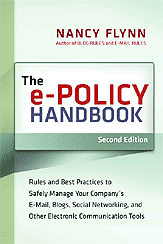Bad eMail Is Bad Business
 |
- 27% of Fortune 500 companies have defended themselves against claims of sexual harassment stemming from inappropriate eMail and/or Internet use.
- Chevron was ordered to pay female employees $2.2 million to settle a sexual harassment lawsuit stemming from inappropriate eMail sent by male employees.
- If a former employee subpoenas company eMail in the course of a wrongful termination lawsuit, you could face an expensive back-up tape search. One Fortune 500 company was ordered to search more than 20,000 back-up tapes at a cost of $1,000 per tape. That's $20 million spent before the case went to trial.
- 50% of employees report receiving racist, sexist, pornographic, or otherwise inappropriate eMail at work.
|
(Source: The ePolicy Handbook by Nancy Flynn, 2001.)
Confused About When To Use eMail?
Avoid eMail When...
1. A message is extremely important or confidential, and you cannot risk a breach of privacy. Never use eMail to communicate proprietary corporate information. With millions of hidden readers and dastardly hackers lurking in cyberspace, eMail simply is not secure.
2. You want to conduct negotiations or hold a give-and-take conversation. Whether you want to negotiate a price reduction with a supplier or persuade your supervisor to give you a pay raise, dialogues that call for back-and-forth discussion are best be held on the phone or in person.
3. You need to conduct a lengthy interview with a long list of questions that call for detailed answers.
4. You want to deliver bad news or discuss an emotionally charged matter. Without the benefit of facial expressions, intonation, and body language, hurt feelings could ensue and flame wars could erupt if you deliver bad news electronically.
5. You seek an immediate response from someone who may not check eMail regularly or who has a tendency to procrastinate.
6. You run the risk of intimidating or turning off the reader with a written message.
7. You suspect your written message may be misunderstood or misconstrued.
Use eMail When....
1. You want to deliver a message quickly and the speed with
which you receive your reply does not matter. eMail is a terrific way to send a quick message, but it is not necessarily the best route to a quick reply. Your reader is under no obligation to read or act upon your message in a timely fashion.
2. You want to communicate directly with the decision-maker, rather than fight your way past a gatekeeper. As long as you have the decision-maker's correct eMail address, chances are your message will be read by your intended reader. Few people have assistants screen their eMail.
Bear in mind, however, senior executives are busy people. As such, they may be impatient with wordy or poorly constructed messages. Follow the organization's eWriting guidelines to ensure your eMail messages are powerful, persuasive documents that motivate readers to act.
3. You want to avoid the cost of long-distance phone calls and faxes, local or overnight delivery services, and/or snail mail.
4. You need to communicate with a colleague or a
customer in a different time zone or country, and you don't want to
get out of bed in the middle of the night to make a phone call.
Thanks to eMail, both the sender and the receiver can conduct business during normal working hours.
5. You want to deliver the same message to multiple readers. Whether it is a memo intended for six readers or an electronic newsletter with 6,000 subscribers, eMail makes it easy to deliver news quickly, easily, and inexpensively.
6. You need to maintain a written record of your electronic conversation. Before saving a message, however, review the company's document retention and deletion policy or ask your supervisor for authorization to store the eMail.
7. You are on a tight deadline. If an assignment is due on the president's desk at 8:00 Monday morning, you can work all weekend, send the document Sunday night, and sleep soundly, knowing your material is sitting in the boss's mailbox, awaiting review.
Be careful not to wait until the last minute, however. Electronic delays and eMail delivery problems sometimes occur. While the majority of messages are delivered without problems, there always is the possibility that your recipient's mail server will be down, keeping your message from getting through.
8. You want to communicate quickly and cost-effectively with coworkers. Why waste paper and time writing and distributing hard copies of memos when you can send internal eMail messages with a click of your mouse. Just remember that the organization's netiquette policy and cyberlanguage guidelines apply to internal eMail as well as external correspondence.
9. You need to stay in touch with the office and your
customers when you are on the road. eMail can be accessed from anywhere, as long as you can log onto the Net. Electronic communication beats phone tag any time, particularly for weary travelers caught between flight schedules, time zones, and competing priorities.
Excerpted from The ePolicy Handbook 2001 and Writing Effective E-Mail 1998 .
Permission to reprint granted, provided the material is reproduced in its entirety and
www.epolicyinstitute.com is cited as the source. Click here to order The ePolicy Handbook or Writing Effective E-Mail.
Netiquette Tips for Managers
©Copyright 2002, 2001, The ePolicy Institute. All content is the property
of The ePolicy Institute. Visitors may reprint or repost content for
non-commercial use only, provided the following citation is included:
2002, 2001 The ePolicy Institute, Executive Director Nancy Flynn,
e-mail experts@epolicyinstitute.com.





